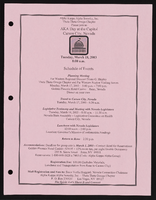Search the Special Collections and Archives Portal
Search Results
Lee White oral history interview
Identifier
Abstract
Oral history interview with Lee White conducted by Claytee D. White on May 18, 2021 for African Americans in Las Vegas: a Collaborative Oral History Project. Lee White played professional football for the New York Jets, Los Angeles Rams, and San Diego Chargers. A promising career as a first round draft pick resulted in an injury in his first professional game. He retired from football at the age of 28 and moved back to Las Vegas where he had grown up on the Westside. Lee entered the hotel and casino industry as a dealer, retiring twenty-five years later as a Vice President of Casino Operations. His career in the tourism industry included work at the Sands, MGM, Desert Inn, and the Tropicana.
Subjects discussed include: Westside School, Weber State College, and the Sahara Hotel and Casino
Archival Collection
Mary Wilson oral history interview
Identifier
Abstract
Oral history interview with Mary Wilson conducted by Patricia Conerly on March 23, 1976 for the Ralph Roske Oral History Project on Early Las Vegas. In this interview Wilson discusses her personal experiences in Las Vegas, Nevada as an African-American woman living in Las Vegas in the 1950s and onward.
Archival Collection
Carter Family oral history interviews
Identifier
Abstract
Oral history interviews with Leon Carter Sr., Ruth Jimerson-Carter, Leon Carter Jr., and Herman Jimerson Jr. conducted by Claytee D. White on January 18 through March 18, 2021 for African Americans in Las Vegas: a Collaborative Oral History Project. Leon Carter Sr. talks of his childhood, time spent playing baseball after graduating high school, and the various professions he's held including working at the Nevada Test Site, working in construction, and entering the casino industry as a dealer. The Carter Family discuss life on the Westside and their respective histories.
Archival Collection

Alpha Kappa Alpha Sorority, Theta Theta Omega Chapter "AKA Day at the Capitol" schedule and supplementary resources
Date
Archival Collection
Description
From the Alpha Kappa Alpha Sorority, Incorporated, Theta Theta Omega Chapter Records (MS-01014) -- Chapter records file.
Text
Anna Bailey oral history interview
Identifier
Abstract
Oral history interview with Anna Bailey conducted by Claytee White on March 03, 1997 for the Women's Research Institute of Nevada (WRIN) Las Vegas Women Oral History Project. Bailey opens her interview by describing her early life, family, and dance training. She discusses moving to Los Angeles, California at age fifteen, her first dancing gigs, and touring in London, England. She also talks about her experiences as an African American dancer including issues with segregation while touring in the southern United States. Bailey then discusses her life in Las Vegas, Nevada in the 1950s, and working as a dancer at the Moulin Rouge. She describes the club, the other dancers that performed there, and how the African American community felt when the club closed. Bailey then discusses how her husband and the entertainers Josephine Baker and Frank Sinatra helped integrate Las Vegas. She ends her interview by describing the last hotel she danced at, the Flamingo, where she performed in an integrated dance line.
Archival Collection

Newspaper article, Night for youths, All-Day workshop head many events, Las Vegas Sun, February 9, 1965
Date
Archival Collection
Description
Newspaper article featuring information about the Negro National History Week events taking place in schools and churches in February 1965.
Text
Audio clip from interview with Essie Lee Jones by Claytee White, June 5, 1996
Date
Archival Collection
Description
Part of an interview with Essie Lee Jones, June 5, 1996. In this clip, Jones describes racism she encountered while she was working as a waitress.
Sound
Audio recording clip of interview with Dr. Agnes Lockette by Shannon Smith, February 26, 1980
Date
Archival Collection
Description
Part of an interview with Dr. Agnes Lockette by Shannon Smith on February 6, 1980. Lockette describes developing the early childhood education program at the University of Nevada, Las Vegas, and describes challenges in the Las Vegas public school systems during the population boom of the 1950s.
Sound
Ruby Amie-Pilot Papers
Identifier
Abstract
The Ruby Amie-Pilot Papers (approximately 1930s-2002) contains newspaper clippings about events in West Las Vegas, Nevada, family photographs, and a memorial program from Robbie Tyler's memorial service. Also included in the collection are newspaper clippings containing a portion of the cartoon series her son Ronald Terry Amie published in the
Archival Collection
Julia Payne oral history interviews
Identifier
Abstract
Oral history interviews with Julia Payne conducted by Claytee D. White on February 11, 2004 and March 07, 2004 for the Boyer Early Las Vegas Oral History Project. In the first interview, Payne discusses arriving to Las Vegas, Nevada in 1961. She describes discrimination, redlining on the Westside, and recalls the lack of integration at the time. Payne then discusses Jackson Street and compares it to the Las Vegas Strip. Lastly, Payne talks about Cove Hotel, Hank’s Place, Colony Club, and the decline in African American businesses on Jackson Street. In the second interview, Payne discusses welfare rights, changes to the Westside and growth of suburban areas. She describes her employment with the Southern Nevada Drug Abuse Council and becoming the first African American substance abuse counselor. Lastly, Payne discusses her position as Executive Director of Nevada Treatment Center.
Archival Collection
